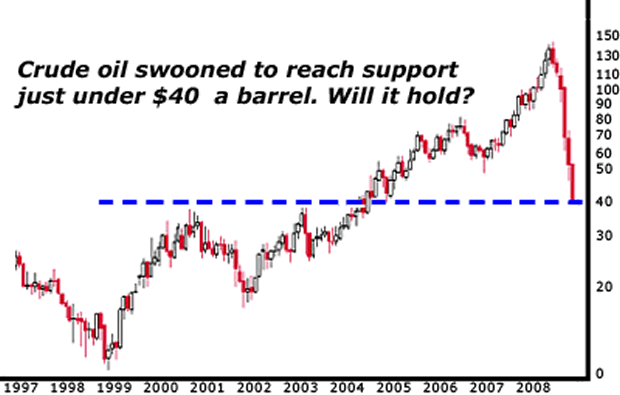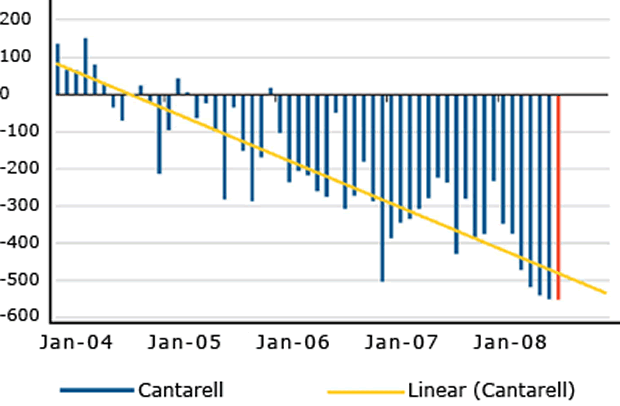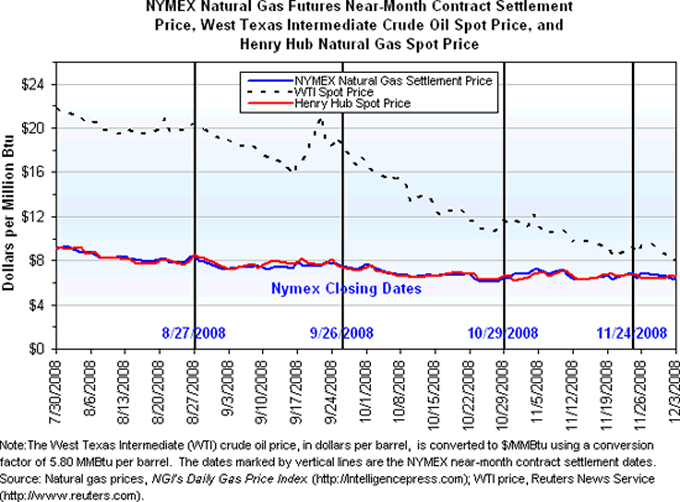Crude Oil Price Carnage Faces Supply Troubles
Commodities / Crude Oil Dec 10, 2008 - 10:17 AM GMT Sean Brodrick writes: As you read this, I'm on my way to check out a new gold project in Mexico that I hope to tell you about in an upcoming Money and Markets column.
Sean Brodrick writes: As you read this, I'm on my way to check out a new gold project in Mexico that I hope to tell you about in an upcoming Money and Markets column.
But I couldn't skip the chance to go into the extraordinary events we saw in the oil markets last week, as crude suffered its biggest weekly drop since the Persian Gulf War in 1991. Here's the scoop …
Global Recession Driving Down Demand
The drop in the price of crude capped a bad week for energy, in which The International Energy Agency, The U.S. Energy Department and OPEC lowered their forecasts for world oil demand, as the global recession tightens its grip.
The U.S., the European Union and Japan — which together consumed 48% of the world's oil in 2007 — are in the first simultaneous recession since World War II.
China, along with other emerging market countries, is expected to provide most of the growth in global oil demand going forward. But China represents only 9% of global oil demand. And it's not immune from the global recession.
In November, China's car sales dropped 10%, the most in three years. So it's not hard to see that the hellhounds of recession may be camped out on China's doorstep.
OPEC — Spoiling the Party
 |
| OPEC's president, Chakib Khelil, admitted last week that oil prices can drop to a very, very low level. |
If you want higher oil prices, the smart thing to do is cut supply. And OPEC agreed late in October to cut production by 1.5 million barrels per day. Yet its members have only cut production by about half that.
A week ago, OPEC president Chakib Khelil said there is no “floor” for the price of a barrel of oil. “Prices can drop to a very, very low level,” he added.
That seems pretty bearish. Then, later in the week, Khelil said that a consensus had formed for “deep” cuts when OPEC meets again on December 17. “An output decision that startles markets would help bolster plunging oil rates.”
But a big OPEC cut isn't going to startle anybody! If anything, there's a risk it won't meet the expectations. In fact, OPEC's reaction to falling prices has been a spectacular series of errors.
However, the pressure isn't really on OPEC. They can still make money at current prices. Other producers can't — especially the new deep-water oil wells that are the major source of new supply. More on that in a moment.
First …
Are We Reaching Support?
All the bad news has propelled oil lower at a breath-taking speed. Now the question is: Will a support price of just below $40 hold?

I thought oil had support at $100, then $90, then $60. Those didn't hold. However, previous monthly tops give oil long-term support just under $40.
Many traders will write off a bounce in crude from $40 as a dead-cat bounce. Maybe they're right.
On the other hand, along with this technical support, there are three additional factors that could support $40 oil prices …
1) Projects are being canceled. First, it was the oil sands projects and deepwater projects in Canada, Brazil, and elsewhere around the world shutting down. Many of these projects had costs at over $50 a barrel.
Now, we're seeing unconventional oil projects shutting down left and right. Unconventional reserves account for 18% of all liquids used, according to the International Energy Agency. And that represents 15.6 million barrels per day.
The major independent oil companies have a cash cost of about $40 a barrel. As their projects start to fall off, we could see global oil production, currently over 86 million barrels per day, fall to 80 million barrels a day … 70 million barrels a day … and lower.
Less supply should bring oil into balance with lower demand. At the same time, if demand goes higher and new supply gets canceled, the next run-up in prices could be fast and furious.
2) Extreme levels of pessimism: Merrill Lynch warns that oil prices could plunge to $25 a barrel in 2009 and average just $50 a barrel. That kind of pessimism may be a signal to take the other side of the trade.
3) Traders have already priced in a lot of bad news: I think it's safe to say that whether oil goes lower will depend on if the central banks around the world can stabilize the economic chaos. Individual political leaders may have an effect as well. For instance, if Obama can roll out a plan to get America moving again six months after he takes office, the market will rush to include that into crude prices.
Then again, if the world economy continues to slump with no relief in sight … and the slump continues for years … Merrill Lynch's $25 prediction may be right after all.
Two Charts That Spell Trouble for Oil Supplies
Even without falling prices, some oil producers are in serious trouble.
Russia, the biggest non-OPEC oil producer, is seeing its production slide month after month.
 |
And it's not just Russia — Nigeria, Indonesia, Great Britain and other oil producers are all on the slippery slope down.
Just look at this chart I picked up from Frank Holmes at US Global Investors.
It shows that Mexico, which is the #3 supplier of US imported oil, is experiencing staggering declines as its “super-giant” Cantarell oil field spirals into collapse.
And then there's this next chart from the Energy Information Administration. It shows that the real price received for oil (on a dollar-per-BTU basis) is getting very close to the price for natural gas.
Natural gas is cheap — it basically comes from sticking a pipe in the ground and has a lower cost basis than crude.
Meanwhile more and more of our oil products come from “heavy sour” crude. This costs a lot more to refine than the “light sweet” crude most of the world's refineries are geared to use. Heavy sour crude accounts for about 45% of the oil and gasoline products we use every day and 70% of the world's reserves.
 |
The big problem is: It can cost hundreds of millions of dollars to upgrade a refinery to process heavy sour crude. So who's going to spend that kind of money if the price of crude oil is near the price of natural gas?
Three Saudi refining projects are already facing upgrading delays. Two more in the UAE are vulnerable. And clouds are gathering over a Kuwaiti project as well.
Tankers Become Floating Storage Vaults
There are 16 oil tankers around the world being used for storage rather than delivery. If full … and they probably are … these tankers hold about 25 million barrels of oil. This is more than the 22.9 million barrels sitting in Cushing, Oklahoma, where oil is stored for delivery against NYMEX contracts.
Why would someone store oil on a tanker?
Because they've run out of land-based storage and can make money by selling that crude against futures contracts.
Much of that stored oil will have to be “worked off” before oil prices can go significantly higher again.
But despite the recession, the U.S. still uses about 19.6 million barrels of crude oil each and every day. So we'll use up that excess oil pretty quickly if supplies are interrupted or even slow down somewhat.
And that's exactly what lower oil prices will do — interrupt supply.
3 Ways to Play Oil
If you think the worst is yet to come for oil, and $25 sounds about right, then consider the PowerShares Double Short ETN (DTO). It targets twice the INVERSE of the percentage movement in oil.
However, if you think oil is cheap now and about to get more expensive, take a look at the PowerShares DB Crude Oil Double Long ETN (DXO). If oil rallies, the DXO should leap ahead.
And if you want to use options, you can buy either calls or puts on the U.S. Oil Fund (USO). It aims to track the price of oil and has options that are liquid enough to trade.
Be careful. But don't stick your head in the sand, either. The best opportunities come at extremes, and we certainly seem to be in extreme markets now.
Yours for trading profits,
Sean
This investment news is brought to you by Money and Markets . Money and Markets is a free daily investment newsletter from Martin D. Weiss and Weiss Research analysts offering the latest investing news and financial insights for the stock market, including tips and advice on investing in gold, energy and oil. Dr. Weiss is a leader in the fields of investing, interest rates, financial safety and economic forecasting. To view archives or subscribe, visit http://www.moneyandmarkets.com .
Money and Markets Archive |
© 2005-2022 http://www.MarketOracle.co.uk - The Market Oracle is a FREE Daily Financial Markets Analysis & Forecasting online publication.



